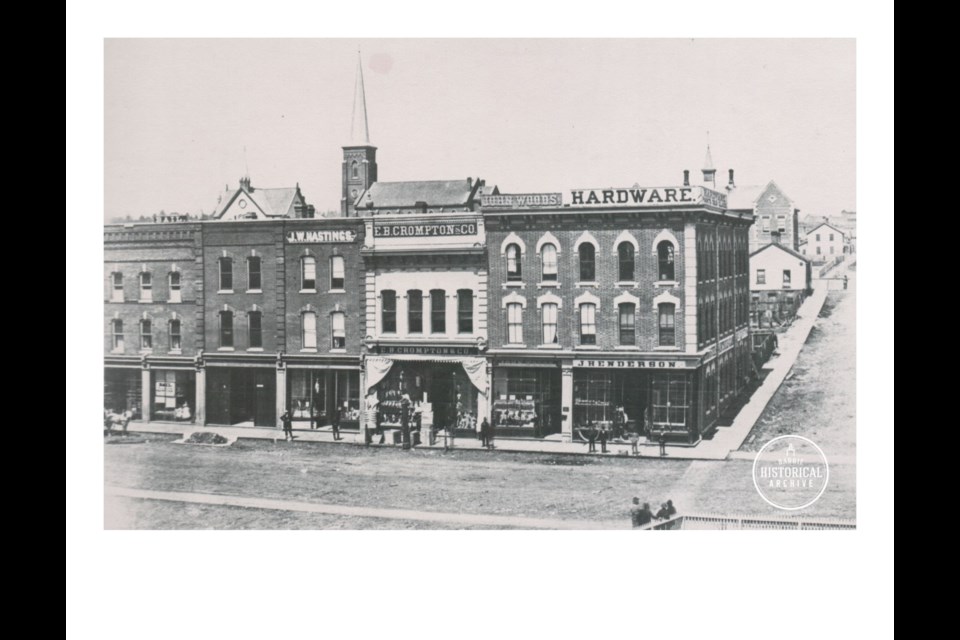Before his shocking disappearance, the world of Sidney J. Sanford appeared to be a place that most would envy.
The popular Simcoe County treasurer lived in one of the town’s more opulent homes with a lovely wife and their rosy cheeked children.
With many friends, and considerable involvement in sporting and social circles, the life of this upper-class gentleman seemed carefree.
What precisely he was thinking we will never know, but in the months leading up to mid-1897, Sidney Sanford must have been keenly aware that his carefully constructed house of cards was about to fall.
As the 19th century was nearing its close, an increasing number of Barrie residents shared the opinion that the town with the backwoods reputation should try to become more urbane, and that a proper opera house was the cultural improvement most desired.
Although Nathaniel King had built a music hall in 1891, most theatrical performances were presented on a stage in the town hall that was deemed by many as beyond inadequate.
Sidney Sanford was a frequent player on the stage and his acting with the local Thespian Club was quite excellent, it was said.
A wealthy man with an appreciation for the performing arts was just the champion the pro-opera camp needed.
In October 1895, Sanford purchased a lot on the south side of Collier Street that is now a paved space next to the western wall of the Collier Street Parkade.
He had local architect Eustace Bird design an opera house fit for a sophisticated population.
A little less than a year later, the finished product was unveiled. The townspeople were thrilled at what roughly $30,000 of Sidney Sanford’s money had funded.
On Monday, Sept. 21, 1896, Mayor Bothwell addressed the audience in attendance on opening night and complimented Mr. Sanford on “being instrumental in giving Barrie such a delightful place to enjoy theatrical and musical riches of the world.”
What was known by Sidney Sanford was shared with his wife, at least in part, by January of 1897 as that is when they jointly took out a mortgage of $3,000 on the opera property.
Whatever financial maneuvering Sanford was attempting had obviously failed by June when the property was sold at the vastly discounted price of $5,000 to James L. Burton, Mrs. Sanford’s uncle.
On June 16, 1897, Simcoe County council was blindsided by a note written by Sidney Sanford and left at Statenborough for his wife to read.
The letter stated that Sidney was short on his accounts in the treasury and that he thought it best that he go away.
He had been gone about a week by this time.
That is when the biggest scandal to rock the small town began in earnest.
Who knew what, and when did they know it?
County council launched an investigation and filed legal proceedings against Sanford.
The deputy treasurer loudly complained that he had been asking for more powers for the entire 12 years of Sanford’s tenure, but had been completely ignored.
Eustace Bird also sued, claiming never to have been paid for his design work.
It was determined that Sidney Sanford had been pilfering from the county cookie jar almost from Day 1. Money was missing from every year that he was in charge of the finances.
The shocking amount was some $62,000, a big sum at that time, and equivalent to more than $1.8 million today.
In Sidney Sanford’s absence, those who had been closest to him were bearing the weight of his deception.
Mr. Burton’s honesty was questioned in a council inquiry just before they took the opera house away from him and paid him one dollar for it.
Mrs. Sanford and the children were put out of their home as the county tried to recover some of their losses.
By 1899, a $200 reward had been offered for the apprehension of the absconded man who was then rumoured to be in Mexico and living in poverty.
The Sanford Committee was formed in order to deal with the ongoing lawsuits that continued to arise, and to deal with the leasing of the opera house and sale of Statenborough. The committee operated well into the next decade.
Sidney Sanford’s exact movements after hurriedly leaving Barrie aren’t completely known, but it appears that he had the connections and the cash to get in on some gold mining in Nicaragua.
His home base was in California, where his wife likely joined him at some point, as it was there that her signature was put to some legal documents connected to the family assets in Barrie.
In 1915, Sanford reportedly offered to give the Town of Barrie some gold stock to make up for his earlier embezzlement.
By this time, Ida Sanford was out of the picture, either by divorce or an early death, as Sidney had a new wife named Eve.
Sidney Sanford’s banking and business experience seem to have served him well, but it may be that his acting expertise was his best asset of all.
Each week, the Barrie Historical Archive provides BarrieToday readers with a glimpse of the city’s past. This unique column features photos and stories from years gone by and is sure to appeal to the historian in each of us.

